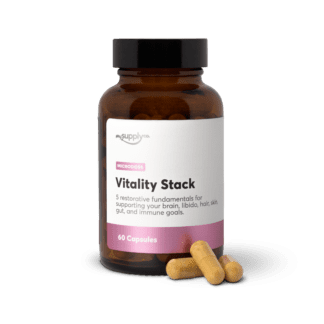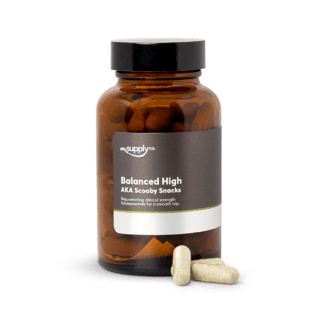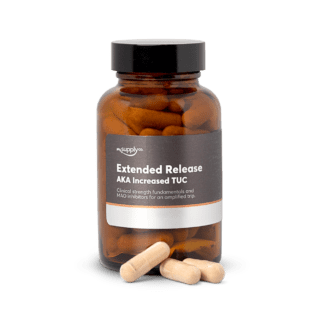How microdose cycling with the right microdosing protocol can help you achieve noticeable results — and maintain them for the long run.
While there's nothing wrong with being health-obsessed, haphazardly microdosing each day may delay microdosing's benefits, or fail to achieve them altogether.
That's where microdose cycling, microdosing schedules, and microdosing protocols comes in.
Why do people microdose?
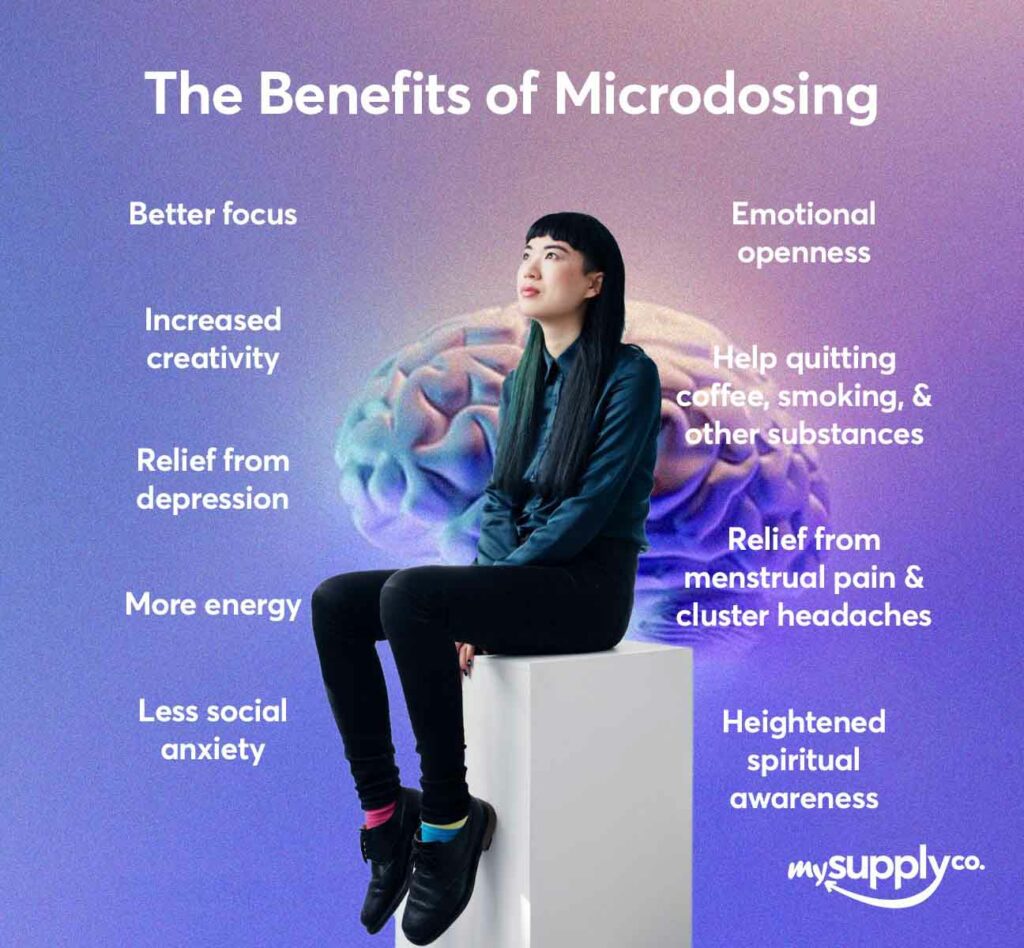
Microdosing began gaining popularity between 2010 and 2013 in Silicon Valley as a way to increase energy and productivity to help brainstorm and tackle roadblocks in strategies and coding. Check out this video by our Head of Marketing and Product Education for a summary of the science and benefits of microdosing Psilocybin, along with tips on how to microdose effectively.
How to Microdose Magic Mushrooms: Protocols, Dosages, and Research-Backed Benefits by @MySupplyCo
While some folks still look to microdosing to improve their professional efficiency, there are a number of other clinically studied benefits. Most commonly:
- enhanced neuroplasticity
- better focus
- enhanced creativity
- relief from depression
- better energy balance and metabolism
- less anxiety, generally and socially
- emotional openness
- help with quitting coffee, pharmaceutical drugs, or other substances
- relief from menstrual pain
- heightened spiritual awareness
- improved gut health, including relief from IBS
These benefits can be attributed to psilocybin's ability to promote healthy serotonin activity and induce rapid and sustained positive changes in brain connectivity.
That's because — in addition to regulating mood and cognition — serotonin is involved in a number of bodily processes, including:
- metabolism
- sleep
- blood clotting
- energy balance
- digestion
- body sugar balance
- cardiac function
- liver function
- immune system response
- pain production
Cycling ensures that each dose you take continues to support these functions and deliver the therapeutic benefits you've come to love.
So, what is cycling, and how does it help you achieve these benefits more effectively and rapidly?
Cycles vs. Protocols vs. Schedules
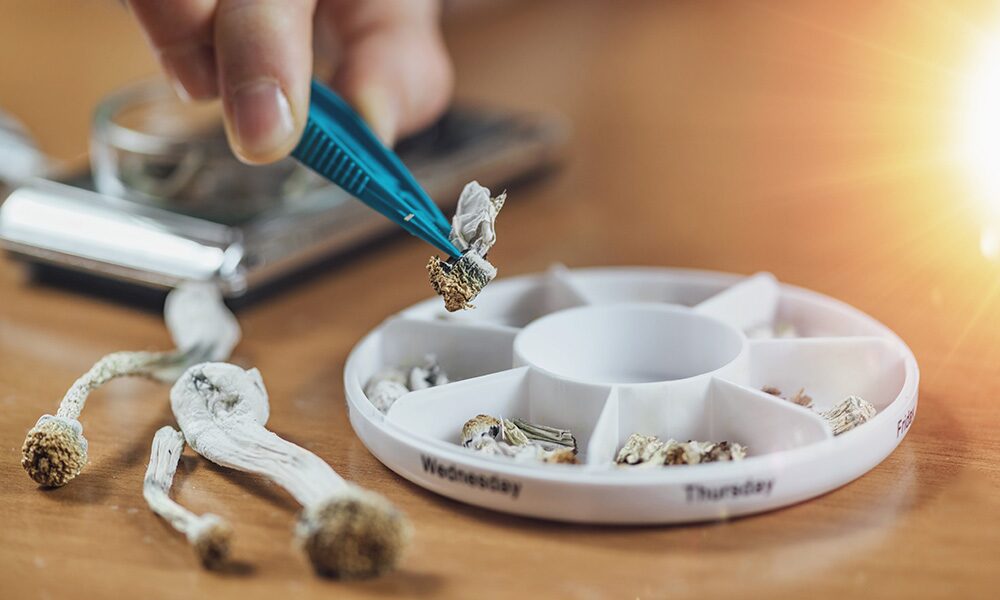
The deeper you get into microdosing, the more technical you realize it is. And with that realization comes a completely new vocabulary. In that vocabulary, these 3 words eseem to have identical meanings and, as a result, are initially confusing to many—but it's not their fault. The lack of clarity stems from how often these terms are used interchangeably, despite their unique importance to the practice of microdosing.
More specifically, we can define these terms as follows:
Microdose cycling is the process of microdosing for set periods of time with breaks in between. This is done to avoid building a tolerance to the substances and to maximize their benefits.
Microdosing protocols are the specific schedules that indicate when and how often to microdose. There are different protocols based on different goals, preferences, and substances. Some of the most well-known protocols are the Fadiman Protocol and the Stamets Protocol.
Microdosing schedules are the individual cycles that follow a microdosing protocol. For example, the Fadiman Protocol recommends microdosing every four days for four to eight weeks, followed by a two to four week break. One microdosing schedule of this protocol would be one cycle.
In short, a full cycle is a schedule within a timeframe that is defined by a protocol. Each protocol defines a specific schedule of microdose days and breaks. When you complete this schedule of microdosing days and breaks, you complete one cycle of the protocol you're following.
So if you are starting your third cycle following the Fadiman Protocol, that would mean you completed the schedule set by that protocol twice.
What is microdose cycling?
Microdose cycling refers to a specific approach where you alternate between periods of microdosing and periods of abstinence from magic mushrooms, or whatever substance you are microdosing. This cycling is done to manage tolerance, reduce potential side effects, and maintain the efficacy of the microdose over an extended period. This means that you can continue to experience the benefits of the microdose without needing to increase your dosage over time.
Practically speaking, and it depends on the microdosing protocol you're following, but microdose cycling involves following a schedule for a few weeks with short 1-3 day breaks between microdosing days, then taking longer breaks to reset your tolerance altogether.
For example, the Stamets Protocol calls for 4 days of microdosing followed by a 3-day break. After 4 weeks of following this protocol, it's recommended you take a 2 – 4 week rest. This schedule completes one full Stamets Protocol cycle.
At this point, you can either repeat the protocol or experiment with a new one. We've included a list of the top 6 protocols and their cycling periods below.
What is a microdosing protocol?
Microdosing protocols, which we list below, are systematic guidelines or plans for how you should engage in microdosing. They typically include specific recommendations for dosage, frequency, and duration, as well as considerations for monitoring effects and maintaining safety.
Microdosing protocols aim to provide you with a structured approach to microdosing. They help establish a consistent regimen for the purpose of enhancing cognitive function, managing symptoms of mental health conditions, or achieving specific goals.
What is a microdosing schedule?
Microdosing schedules refer to a predetermined plan that outlines when and how often individuals should take microdoses of a particular substance, such as psychedelics or nootropics. These schedules can vary widely depending on the substance, the individual's goals, and their response to microdosing.
Microdosing schedules provide a clear timetable for when to take microdoses, with the intention of achieving specific objectives. These schedules may be daily, weekly, or based on a more customized routine, depending on the desired outcome.
In summary, microdose cycling focuses on alternating between microdosing and non-microdosing periods to prevent tolerance. Microdosing protocols provide structured guidelines for how to microdose effectively and safely, encompassing dosage, frequency, and monitoring. Microdosing schedules, on the other hand, are predefined timetables that dictate when and how often microdoses should be taken to align with particular goals and purposes. Each of these concepts plays a unique role in shaping an individual's approach to microdosing and can be adapted to suit their specific needs and preferences.
Benefits of microdose cycling.

Cycling your microdose supplements is beneficial for a number of reasons. Our bodies have an incredible propensity to adapt to external factors and changes in the environment. It’s this innate ability that allows us to gain muscle after lifting heavy weights, or lose body fat when we restrict calories.
But our adaptability can also mean that we become "immune" to the effects of supplements. Exposing our bodies to psilocybin can build up a tolerance over time, so more is needed to achieve the same results.
Microdose cycling helps you avoid this tolerance buildup and guarantees continued health and performance benefits.
The different microdosing protocols.
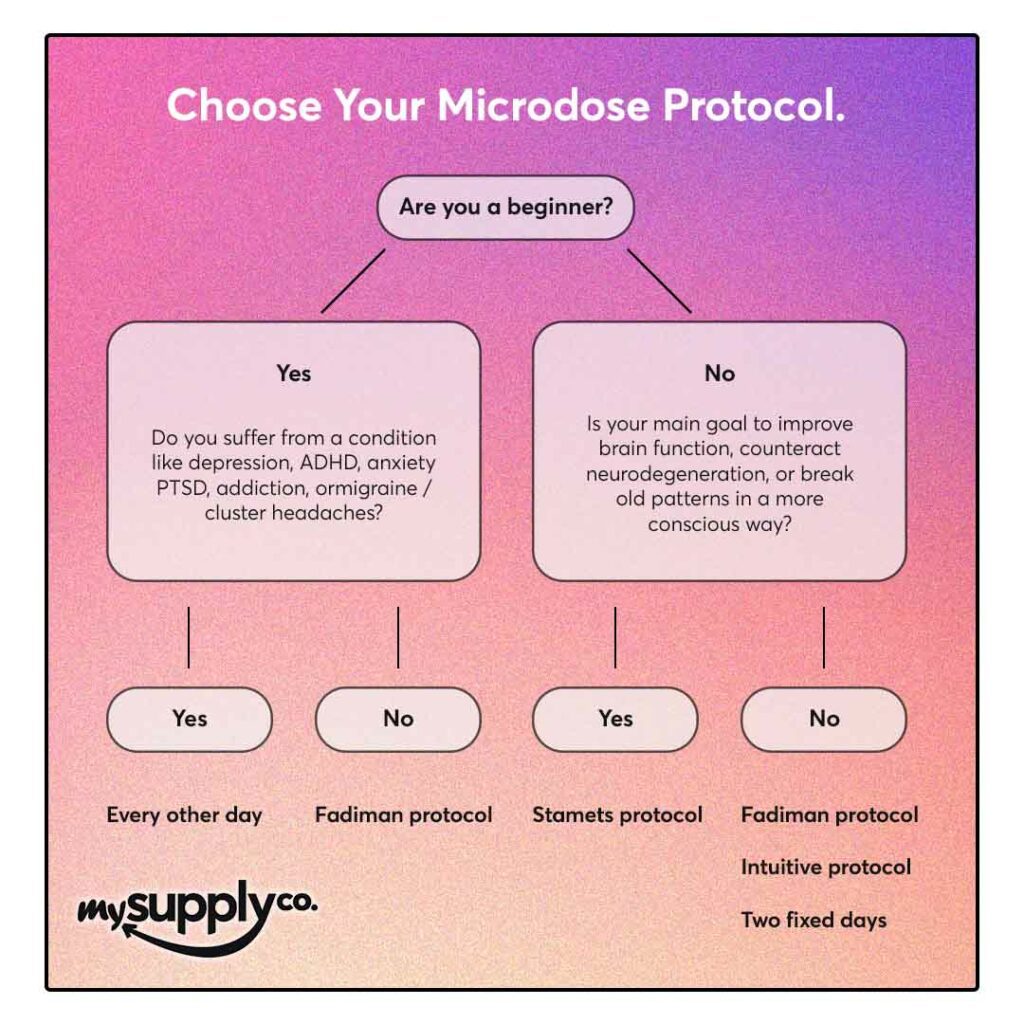
There are many different microdosing protocols. Some are based on science, and some on anecdotal evidence — enough to formulate testable hypotheses. All of them schedule 2 – 4 weeks of rest after a completed microdosing cycle of 4 – 8 weeks. This break — or reset — is vital to avoid tolerance and thus maintain the healing effects of microdosing psychedelics. To determine if a microdosing protocol is suitable for you, we recommend trying each microdosing schedule for at least one month.
The best microdosing protocols for optimizing brain function, personal growth, & performance.
- Stamets Protocol: Developed by mycologist Paul Stamets, this protocol is believed to support cognitive enhancement and overall brain health. Users may find improvements in creativity, focus, and problem-solving abilities.
- Fadiman Protocol: Created by psychologist James Fadiman, this protocol is often associated with improvements in mood, stress reduction, and increased clarity of thought. However, it can be beneficial for individuals seeking relief from mental health conditions such as depression, anxiety, and ADHD, as well as migraines and cluster headaches.
- Nightcap Protocol: May help you enhance YOUR problem-solving abilities, encourage more vivid dreams, and provide potential insights for creativity and self-improvement.
The best microdosing protocols for mental health & well-being (depression, anxiety, ADHD, migraines/cluster headaches).
- Every Other Day Protocol: This protocol is designed for individuals who are new to microdosing and are seeking relief from various mental health conditions such as depression, ADHD, PTSD, anxiety, addiction, migraines, or cluster headaches. However, it may also be suitable for those looking to enhance cognitive function, boost creativity, and maintain mental sharpness over an extended period.
- Two-Days-a-Week (TDAW) Protocol: If you're primarily focused on improving mental health and well-being, this protocol can be beneficial for relief from symptoms of depression, anxiety, ADHD, migraines, or cluster headaches without the commitment of daily microdosing.
1. Stamet's Stack (Stamet's Protocol)
The Stamets Stack by DoubleBlind on YouTube
Paul Stamets, a world-renowned mycologist, author, and advocate for medicinal mushrooms, developed and tested a novel microdosing formula: Psilocybin mushrooms, Vitamin B3 (as Niacin), and the adaptogenic, neuroprotective mushroom Lion’s Mane. This microdosing stacking method has a positive and lasting effect on the brain, promoting neurotrophic growth factors from your own stem cells and protecting your brain from oxidative stress.
Unlocking the Secrets of Lion's Mane Mushrooms! The Science Explained… by StoneAgeMan on YouTube
Paul Stamets coined the term “stacking” to describe the process of combining these ingredients. Find Stamets Stack's ingredients in Brain Stack, our refined take on Paul Stamet's formula.
The Stamets Protocol is an excellent basis for a first microdosing experiment. It assumes a 7-day schedule, which you follow for a 4-week period, with a reset period of 2 – 4 weeks with no microdose. This completes one full Stamets Protocol microdosing cycle.
How to microdose according to the Stamets Protocol:
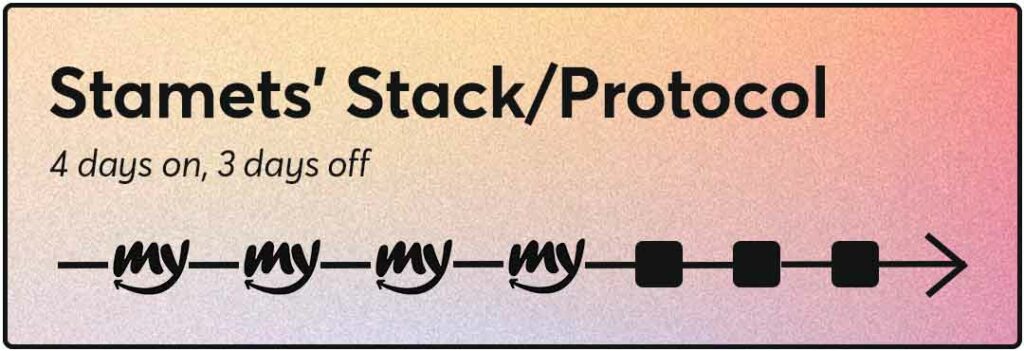
- Day 1 – 4: microdose days (e.g. Monday - Thursday)
- Day 5 – 7: afterglow days (e.g. Friday - Sunday)
Microdose: 4 days
Short Rest: 3 days
Period: 4 weeks
Rest: 2 – 4 weeks
2. Fadiman Protocol
The Fadiman Protocol (also known as the Beginner's Protocol) is the most well-known microdosing protocol. It’s named after Dr. James Fadiman, who created this protocol to observe the effects of mircodosing by clearly distinguishing between microdosing days and non-microdosing days.
Dr. James Fadiman’s protocol is an excellent basis for a first microdosing experiment. It assumes a 3-day schedule, which you follow for a 4 – 8 week period, with a reset period of 2 – 4 weeks with no microdose. This completes one full Fadiman Protocol microdosing cycle.
How to microdose according to the Fadiman Protocol:
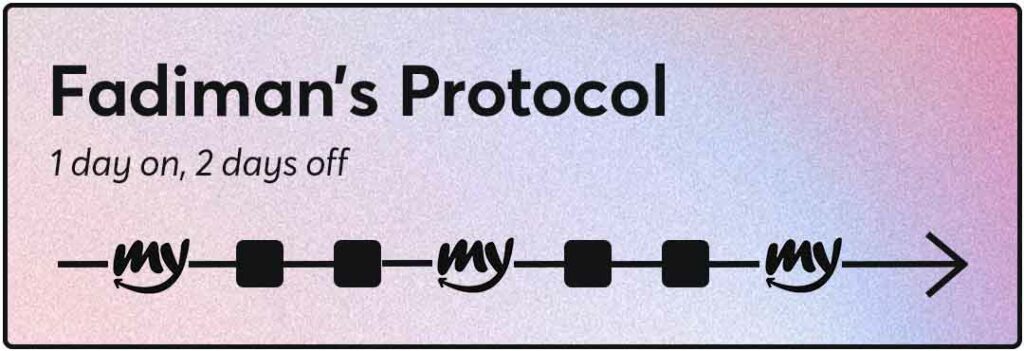
- Day 1: microdose day
- Day 2: afterglow day
- Day 3: afterglow day
Microdose: 1 day
Schedule: 3 days
Period: 4 – 8 weeks
Rest: 2 – 4 weeks
Watch this video in which Dr. James Fadiman shares the "why" behind the Fadiman Protocol with the Microdosing Institute:
Microdosing Expert James Fadiman explains the Fadima Protocol by @MicrodosingInstitute on YouTube
3. My Supply Co. Protocol (every other day)
Early stage research, the experience of microdosing coaches, and users in online forums indicate that some people benefit more from microdosing every second day. This is especially the case when microdosing for medical purposes or psychological challenges such as depression, social anxiety, ADHD/ADD, migraine, or cluster headaches. There is no official term for it, so we dubbed it the My Supply Co. Protocol.
This microdosing protocol should be chosen carefully. If you want to start microdosing for medical purposes, don’t experiment by yourself; consult your doctor or health practitioner first and seek guidance from a microdosing coach.
The MSC Protocol assumes a 2-day schedule, which you follow for a 4 – 8 week period, with a reset period of 2 – 4 weeks with no microdose. This completes one full MSC Protocol microdosing cycle.
How to microdose according to the MSC Protocol:

- Day 1: microdose day
- Day 2: afterglow day
Microdose: 1 day
Schedule: 2 days
Period: 4 – 8 weeks
Rest: 2 – 4 weeks
4. Two-days-a-week (TDAW) Protocol
When microdosing every other day, the microdosing days fall on different days of the week each time. This is not ideal if you prefer a fixed scheme that matches with a weekly work or social routine. If that’s the case, we advise choosing two fixed days in a week that fit your schedule best, and always keep at least one day between each microdosing days.
The TDAW Protocol assumes a 7-day schedule with 2 fixed microdosing days, which you follow for a 4 – 8 week period, with a reset period of 2 – 4 weeks with no microdose. This completes one full TDAW Protocol microdosing cycle.
How to microdose according to the TDAW Protocol:
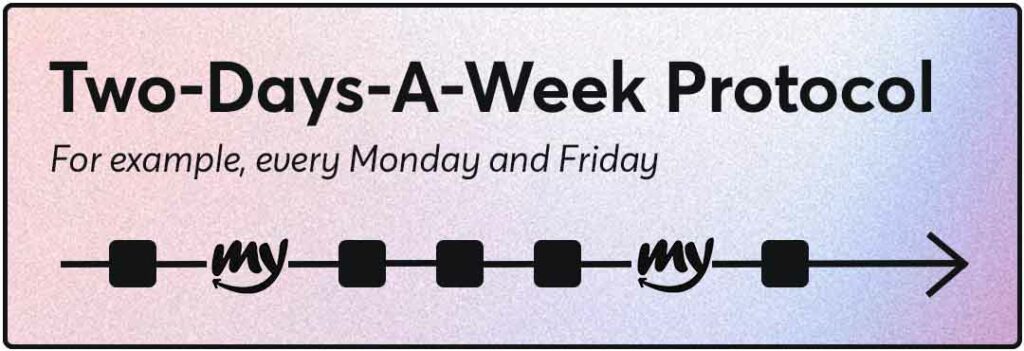
- Monday: microdose day
- Tuesday: afterglow day
- Wednesday: afterglow day
- Thursday: microdose day
Microdose: 2 fixed days
Schedule: 7 days
Period: 4 – 8 weeks
Rest: 2 – 4 weeks
Watch this video about how filmmaker Tyler Mann became one of the many to find relief from cluster headaches — AKA suicide headaches — thanks to the power of psychedelic mushrooms.
5. Nightcap Protocol
Some people experience slight fatigue while microdosing magic mushrooms. If this happens to you, you may be taking more than you need to for a microdose. For many, this is also a choice and preference, as it allows them to relax and ease into their night routine. Therefore, we devised the Nightcap Protocol. This involves microdosing every second day before bedtime to take advantage of this weariness and get a decent night’s sleep.
People who follow this microdosing protocol report having more vivid dreams and waking up feeling more bright and refreshed.
When using the Nightcap Protocol, we recommend taking the microdose at least an hour before going to bed. Mushrooms, truffles, and B.Caapi vine can be microdosed using the Nightcap Protocol, but do not use this protocol when microdosing with LSD, 1cP-LSD, or 1P-LSD!
How to microdose according to the Nightcap Protocol:
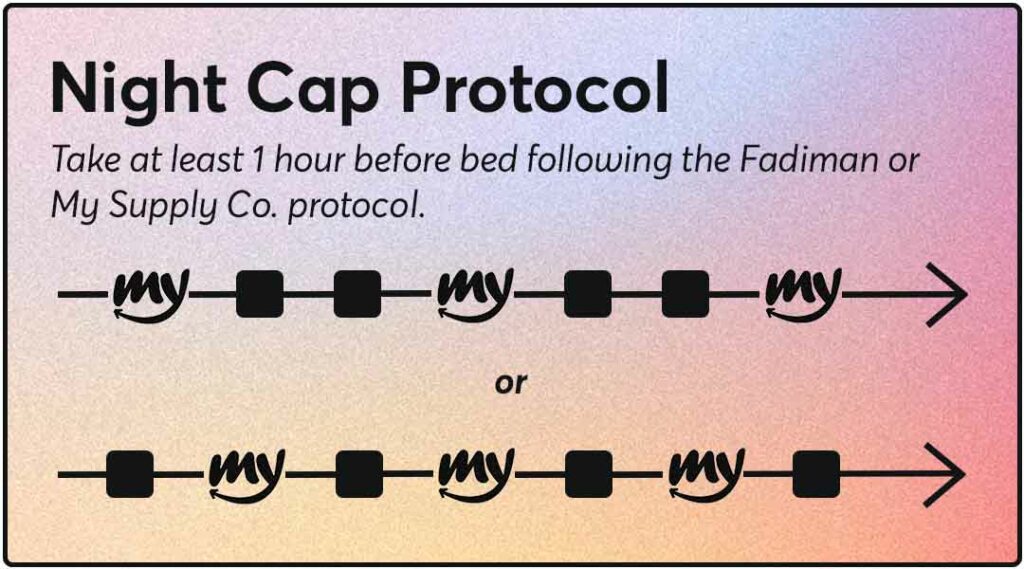
Option 1:
Following the My Supply Co. Protocol:
- Night 1: microdose day
- Night 2: afterglow day
Microdose: 1 day
Schedule: 2 days
Period: 4 – 8 weeks
Rest: 2 – 4 weeks
Option 2:
Following the Fadiman Protocol:
- Night 1: microdose day
- Night 2: afterglow day
- Night 3: afterglow day
Microdose: 1 day
Schedule: 3 days
Period: 4 – 8 weeks
Rest: 2 – 4 weeks
6. Intuitive microdosing
Another way of microdosing is to do it entirely intuitively, with only one rule: you always leave at least one day between the days you take a microdose. People who have followed any kind of microdosing protocol for one or two cycles often switch to a more intuitive way of microdosing.
Does the mushroom strain matter in your microdosing schedule?

When embarking on a microdosing journey with magic mushrooms, you may wonder whether the specific strain of the mushroom plays a significant role in determining your microdosing schedule. While strains can have varying levels of psychoactive compounds, the choice of strain isn't necessarily the primary factor affecting your microdosing regimen.
Here are some key considerations:
1. Psilocybin content.
Different strains of magic mushrooms can have varying levels of psilocybin, the compound responsible for their psychoactive effects. It's essential to choose a strain with a known and consistent psilocybin content if you're microdosing for therapeutic or cognitive enhancement purposes. Consistency allows you to better estimate your microdose and its effects.
2. Personal tolerance.
Individual tolerance to psilocybin can vary widely, regardless of the strain. Factors such as body weight, metabolism, and brain chemistry play a significant role in how psilocybin affects you. This means that what might be a microdose for one person could be perceptual for another.
3. Intent and goals.
Your reasons for microdosing significantly influence the schedule you choose, regardless of the strain. If you're microdosing to enhance creativity or productivity, a different schedule may work for you than if you're microdosing to manage symptoms of depression or anxiety. Your intent and goals should guide your microdosing regimen.
4. Experience levels
Experienced psychonauts may be comfortable with a more potent strain and a flexible self-adjusted schedule, while those new to microdosing might prefer a more structured approach. Novice users often benefit from starting with a recognized psilocybin content strain, as it can help establish a baseline understanding of how they respond to microdoses.
Which microdosing protocol suits you?
The second best way to discover which microdosing protocol suits you best is simply by trying them out. The best way is to try them out, but with somebody who is qualified to prepare and guide you through the psychedelic journey, like a psychedelic therapist. We recommend starting with Stamet's Protocol or the Fadiman Protocol. The important thing is to become aware of the contrast between an ordinary and a microdosing day. To properly investigate what microdosing can do for you, we recommend writing your observations down in a journal or tracking them via an app.
After your first cycle, or if you experience adverse effects, you can decide to switch to another microdosing protocol. Now you are ready to get started with microdosing!


